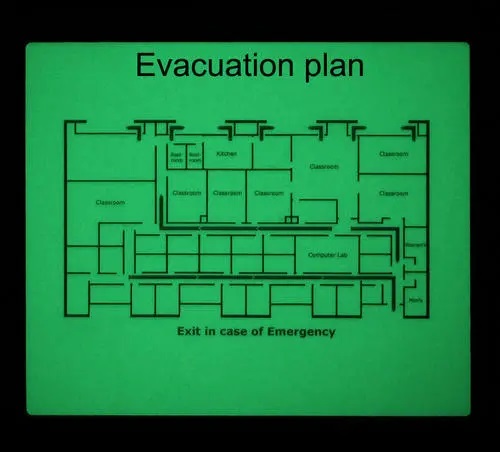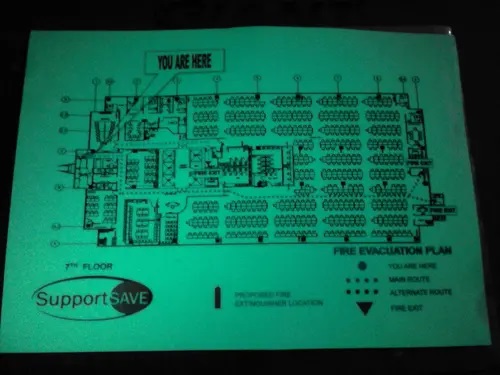The luminescent fire emergency evacuation plan
A fire emergency evacuation plan (FEEP) is the written or composed document that includes the action to be practiced by all staff in the event of the fire and the arrangements for calling the fire brigade. It can include any relevant information to the FEEP.
The General Fire Notice
For the small premises or workplaces, this could take the form of a simple fire action sign or symbols posted in positions where staff & associated persons can understand it and become familiar with the contents.
Staff Fire Notice
Substantial fire risks or big or large premises will require more detailed emergency evacuation plan which takes account of findings of risk evaluation or assessment, e.g. staff significantly at risk and their premises or the location. Also, notices giving clear and concise instructions of the routine to follow in case of fire should be prominently displayed.
In some instances, you should nominate persons to implement the fire action plan and give them adequate training in firefighting and evacuation procedures. The following items should consider where appropriate:
Fire evacuation strategy
Action on discovering a fire
The Action on hearing the fire alarm
Calling the fire brigade
Power/process isolation
Identification of key escape routes
Fire wardens/marshals
Places of assembly and roll call
Firefighting equipment provided
Training required
Personal Emergency Evacuation Plan
Connection with emergency services
Fire Evacuation Plan or Strategy

You need to examine how you will organise the evacuation of the premises in the light of your risk assessment or evaluation and the other fire precautions you have or think to put in place.
Simultaneous Evacuation
In most premises, the evacuation in case of fire will merely be using everyone reacting to the warning signal given when a fire is detected, then making their way, using escape plan, to a place of safety aside from the premises. It is known as a simultaneous evacuation and will typically initiate by the sounding of the general alarm over the fire warning system.
Vertical Phased Evacuation.
In some larger complex premises, the emergency arrangements are designed to allow people who are not at immediate risk from fire to slow starting their abandonment or evacuation.
It may be suitable to start the evacuation by initially evacuating merely the area nearest to the fire and warning other people to standby. This is done by the immediately leaving the floor where the fire is located and the floor above.
The other floors are then evacuated one by one to avoid congestion on the escape routes. The rest of the people are then left if it is necessary to do so. The fire warning system should be capable of giving two distinctly different signals (warning and evacuation) or give appropriate voice messages.
Horizontal Phased evacuation hospitals, and care homes the floor may classify into some fire resisting compartments and the occupants are transferred from the compartment involved in fire to the adjacent compartment and if necessary moved again.
Depending on the fire position or condition, it may ultimately be essential to consider upright or vertical evacuation. Because of the additional time, this type of abandonment or evacuation takes, other fire precautions maybe be needed or required.
These include:
The voice alarm systems
The fire control points
The compartmentation of the premises using fire-resisting construction
The sprinklers in buildings where the topmost floor is 30 meters or more over ground level
Staff Alarm Evacuation (Silent Alarm)
In some cases, it may not be suitable for a general alarm to start the quick evacuation. (Cinemas and Theaters) This could be when the number of members of the public available or present and the need for the workers or staff to put pre-arranged plans for the safe evacuation of the premises into action.
In such circumstances, a staff alarm can be given (by fire records, personal pagers, discreet sounders or a coded phrase on a public address system etc.). Following the staff alarm, a more general alarm signal can give, and a concomitant or phased evacuation of workers or employees started. The general alarm may be initiated automatically if manual initiation has not taken place within a pre-determined time.
Defend in Place
This strategy may consider in blocks of flats were each flat is a minimum 60 minutes fire resisting compartment. It may also think in hospitals, or nursing homes were patients are connected to life-supporting equipment and cannot move. The concept allows the occupants to stay put and will enable the fire service to extinguish the fire in the premises or workplaces. If the fire spreads and it cannot be controlled, then they will initiate a full evacuation. In the case of patients connected to life-supporting equipment then a decision would have to be performed which alternative or option is good or best, stay or move, either way, the patient would be at the serious risk.
You should only plan to use back or defend in place or phased evacuation plans or the schemes, or a staff alarm system if you have sought the advice of a competent or skilled person and the fire and rescue services. Action on discovering a fire:
On finding or seeing the fire or light, every person must sound the nearest or closest fire alarm immediately. The plan should include the method of raising the alarm or signals in the case of fire.
Action On Hearing the Fire alarm
The plan should guide all personnel or employee upon on hearing the fire alarm to operate or act on the agreed FEEP strategy or policy and
If a fire warden’s scheme is in force they, on discovering or hearing the alarm, should progress to pre-determined positions to help members of the public and staff to leave the building by the nearest safe route.
Lifts and escalators should not be used due to possible electrical failure unless they are part of a Personal Emergency Evacuation Plan.
Employees should not re-enter the building with the possible exception of the Fire Team.
Calling the Fire Brigade
The Fire Service should also be informed immediately, either by switchboard operator or person discovering fire, dependant on conditions.
Work Time – Switchboard operator to be conversant with the emergency evacuation plan, also should ensure necessary extensions switched through when switchboard is unattended.
Other Times – Remainder of Staff (Cleaners, caretakers etc.) also to be conversant with the method or procedure. In any case, the superior official should guarantee that Fire Service is summoned when an outbreak of fire.
Power/Process Isolation
Close Down Procedure – Adopt your own ‘ Close Down’ procedure as appropriate
Identification of Key Escape Routes
At premises or workplaces, where members of the public and persons strange with the design of the premises are present, there should be medians available to identify the key escape routes for the employees or the workers. They could include schematic drawings and most importantly emergency escape and exit signs.









